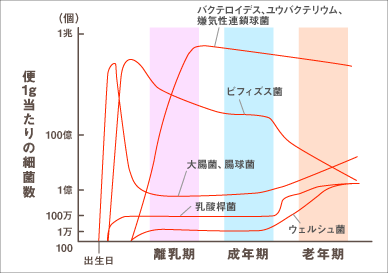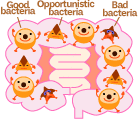Introduction to intestinal flora, lactic acid bacteria, and the intestines
100 trillion bacteria are living in the intestines.
When we eat food, its nutrients are digested in the stomach and intestines, and the remainder is discharged as urine and stool. There are about 30 to 50 billion bacteria per gram of a healthy adult’s stool, which means that roughly 50% of stool is made up of bacteria. Most of those bacteria live in the intestines, where there are far more bacteria living than are found in stool. Indeed, research has found that there are as many as 100 trillion bacteria inhabiting the intestines at any given moment, consisting of 500 to 1000 different types.
Well-known E. coli and bifidobacteria are part of such intestinal microbiota. These bacteria are closely related to our physical condition and health. Indeed, each of these innumerable bacteria has various unique functions and constantly affects our health.
The good, the bad, and the opportunistic bacteria living in our intestines
While there are 500 to 1000 different types of bacteria living in our intestines, some of them are considered good bacteria for their health-positive effects, while others are considered bad bacteria for their negative effects on the body.
Their total volumes are mostly constant, but when the population of good bacteria increases, that of bad bacteria decreases, and vice versa.
Therefore, the balance of power between good bacteria and bad bacteria in the intestines has significant health implications.
|
<Good bacteria>
These are considered health-positive bacteria that assist digestion and absorption, and improve resistance to diseases.
Representative species: Bifidobacteria, Lactobacillus acidophilus, Lactobacillus gasseri
To proliferate, they feed off oligosaccharides, and lactose contained in milk and yogurt.
|
 |
 |
|
<Bad bacteria>
These are considered health-negative bacteria that cause inflammation and produce carcinogenic substances.
Representative species: Escherichia coli, Clostridium perfringens, Staphylococcus, and other putrefactive bacteria
They devour and break down proteins into various harmful substances as they proliferate.
|
 |
 |
<Opportunistic bacteria>
These bacteria have neither health-positive nor health-negative functions.
They remain calm if the population of good bacteria is dominant, but can cause harmful effects if the population of bad bacteria increases.
Lactic acid bacteria’s intestine-regulating effect and intestinal microbiota
The population of bacteria that is formed in the intestines, like a patch of plants, is called the intestinal microbiota or intestinal flora. Human health is closely tied to the balance of this intestinal microbiota, which is dependent on the power dynamics between the populations of good and bad bacteria. Research has shown that lactic acid bacteria help improve this balance in the intestinal microbiota. The lactic acid bacteria contained in yogurt promote the proliferation of good bacteria in the intestines.
Bacteria age as their host ages
|
Immediately after a baby is born, there are no bacteria living inside the intestines. However, E. coli and enterococci soon start inhabiting the intestines. Then, three to four days after birth, bifidobacteria (good bacteria) suddenly emerge and become dominant, reducing the population of E. coli and enterococci. Thereafter, a normal balance in the intestinal microbiota is maintained. In the intestines of a baby, the population of bifidobacteria (the main type of good bacteria) that feed off the lactose contained in the breast milk and milk ingested by the baby becomes dominant. As the baby is weaned off the milk and starts eating various types of food, the balance in the intestinal microbiota will gradually shift toward what’s considered normal in an adult.
In this transition process, the types of bifidobacteria that inhabit the intestines also change, from infant types to adult types. Then, later in life, as the person passes through adulthood and becomes elderly, the population of bifidobacteria living in the intestines declines, while putrefactive bacteria such as C. perfringens along with E. coli and lactobacilli increase in number. This shift is considered to be the result of age-induced deterioration of stomach acid and intestinal functions, which causes food to remain in the intestines longer and create an environment where bad bacteria can proliferate more easily.
|
 |
 Figure drawn from the book Chōnai-Saikin No Hanashi authored by Dr. Tomotari Mitsuoka (Iwanami Shinsho)
Figure drawn from the book Chōnai-Saikin No Hanashi authored by Dr. Tomotari Mitsuoka (Iwanami Shinsho)
|
Exposure to stress changes the balance
While the balance of the intestinal microbiota is affected by the age of the host, there are also other factors that affect the bacteria’s power dynamics, such as stress and disease.
The word “stress” is usually associated with various mental stresses experienced in everyday life, such as worries and mental fatigue. However, physical stresses such as heat, cold, physical fatigue, and nutritional deficiency are also stresses. Especially when one is subjected to tremendous mental stress, the number of bifidobacteria living inside the body sharply declines, which causes the intestinal microbiota to shift to the senior type. When this happens, it takes around a week for the microbiota to return to its normal state. In addition, disease, surgery, antibiotics, and other similar events of course have a major effect on the host’s microbiota.
As explained above, the intestinal microbiota can be affected by various factors, as the bacteria’s power dynamics change constantly.





